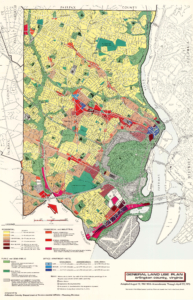 This map was created by the Arlington County Department of Environmental Affairs showing the population distribution as well as the locations of businesses—see the right-hand side of the legend. The consistent distribution of the population, the complete lack of farmland, and the relatively limited green space are in stark contrast to how Arlington looked in the 1700s, 1800s, and even in 1900, when the area was mostly farmland and sparsely populated. The population density and urban expansion show a visible increase since the 1940s. A major source of this population growth was immigration—a fact that has held true since initial settlement and was evident during the Civil War, when Black communities grew and flourished. In the 1970s, a major source of immigrants to Arlington was the Vietnamese diaspora, consisting of those fleeing the fall of South Vietnam. Many traveled to the D.C. area because it reminded them of their homes in Vietnam and because of the connections they made with U.S. officials and sponsors in the Catholic Church, who encouraged many to settle in Northern Virginia, including Arlington. This influx of Vietnamese immigrants influenced Arlington’s culture and geography, creating a Vietnamese enclave in Clarendon known as “Little Saigon.” This enclave faded away due to redevelopment plans related to the expansion of the Metro, which caused rents to rise. Despite its disappearance, Little Saigon represents the influence that immigrants have on the Arlington community, a legacy still visible today as people from all over the world choose to make their homes in Arlington County.
This map was created by the Arlington County Department of Environmental Affairs showing the population distribution as well as the locations of businesses—see the right-hand side of the legend. The consistent distribution of the population, the complete lack of farmland, and the relatively limited green space are in stark contrast to how Arlington looked in the 1700s, 1800s, and even in 1900, when the area was mostly farmland and sparsely populated. The population density and urban expansion show a visible increase since the 1940s. A major source of this population growth was immigration—a fact that has held true since initial settlement and was evident during the Civil War, when Black communities grew and flourished. In the 1970s, a major source of immigrants to Arlington was the Vietnamese diaspora, consisting of those fleeing the fall of South Vietnam. Many traveled to the D.C. area because it reminded them of their homes in Vietnam and because of the connections they made with U.S. officials and sponsors in the Catholic Church, who encouraged many to settle in Northern Virginia, including Arlington. This influx of Vietnamese immigrants influenced Arlington’s culture and geography, creating a Vietnamese enclave in Clarendon known as “Little Saigon.” This enclave faded away due to redevelopment plans related to the expansion of the Metro, which caused rents to rise. Despite its disappearance, Little Saigon represents the influence that immigrants have on the Arlington community, a legacy still visible today as people from all over the world choose to make their homes in Arlington County.

 Department of Community Affairs 1983 Map
Department of Community Affairs 1983 Map